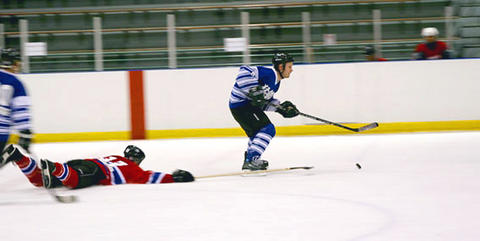In the travelogue Tropic of Hockey: My Search for the Game in Unlikely Places, Canadian writer and rocker Dave Bidini tells how he rediscovered the game he loved by playing the sport off the beaten track.
Though he never made it to Taiwan - there wasn't a well-established hockey league on the island at that time - the book reveals why people are willing to pack up their skates and sticks and haul them all over the world.
It's a sentiment Mike Thorburn understands well. When the 24-year-old was deciding where to teach in Asia, he narrowed his choices down to Korea, Japan and Taiwan. He chose Taiwan, in part, because of the Chinese Taipei Ice Hockey League (CIHL, 中國冰球聯盟).

PHOTO: COURTESY OF THE CHL
"That was [what] really got me over here," he said to the Taipei Times over a hot cup of coffee in the icy belly of the Taipei Arena (臺北小巨蛋).
The Toronto native says that living in a country that pays foreign teachers relatively well is fun, and hitting the ice here is a nostalgic reminder of home - minus, of course, the below-zero temperatures.
Thorburn's sentiments are shared by many of the other players in the International Division of the CIHL who have recently arrived and by those debating whether to sign on for another season.
In addition to playing, Thorburn has joined the league's committee of representatives - a group that interacts with the local community to increase the profile of hockey in Taiwan.
The league's organizers are made up of players who volunteer their time because they love the sport and want to pass the game on to others.
"We are out here for fun," Thorburn said when asked about egos and the fights that often accompany professional hockey games in North America. "I mean nobody is getting paid."
The CIHL consists of two divisions. The larger of the two is the International Division, which is composed of roughly 100 players, a quarter of whom are Taiwanese, playing on eight teams. Five of the teams are from Taipei, with the remaining three based in Taichung, Chiayi and Kaohsiung.
Although hockey doesn't rival baseball in popularity, the CIHL has seen its numbers grow. That rise has been matched by an increase in the number of games played. "Last year there were 14 games," Thorburn said, "this year there are 21."
The Club Division has four teams, is composed strictly of Taiwanese people and pits players at the same level against each other. Players in the Club Division can be drafted into the International League, but the competition there is tougher.
To help promote hockey on the island and entice players to hit the ice, the league subsidizes the fees and sponsors all the local players.

Nov. 11 to Nov. 17 People may call Taipei a “living hell for pedestrians,” but back in the 1960s and 1970s, citizens were even discouraged from crossing major roads on foot. And there weren’t crosswalks or pedestrian signals at busy intersections. A 1978 editorial in the China Times (中國時報) reflected the government’s car-centric attitude: “Pedestrians too often risk their lives to compete with vehicles over road use instead of using an overpass. If they get hit by a car, who can they blame?” Taipei’s car traffic was growing exponentially during the 1960s, and along with it the frequency of accidents. The policy

While Americans face the upcoming second Donald Trump presidency with bright optimism/existential dread in Taiwan there are also varying opinions on what the impact will be here. Regardless of what one thinks of Trump personally and his first administration, US-Taiwan relations blossomed. Relative to the previous Obama administration, arms sales rocketed from US$14 billion during Obama’s eight years to US$18 billion in four years under Trump. High-profile visits by administration officials, bipartisan Congressional delegations, more and higher-level government-to-government direct contacts were all increased under Trump, setting the stage and example for the Biden administration to follow. However, Trump administration secretary

The room glows vibrant pink, the floor flooded with hundreds of tiny pink marbles. As I approach the two chairs and a plush baroque sofa of matching fuchsia, what at first appears to be a scene of domestic bliss reveals itself to be anything but as gnarled metal nails and sharp spikes protrude from the cushions. An eerie cutout of a woman recoils into the armrest. This mixed-media installation captures generations of female anguish in Yun Suknam’s native South Korea, reflecting her observations and lived experience of the subjugated and serviceable housewife. The marbles are the mother’s sweat and tears,

In mid-1949 George Kennan, the famed geopolitical thinker and analyst, wrote a memorandum on US policy towards Taiwan and Penghu, then known as, respectively, Formosa and the Pescadores. In it he argued that Formosa and Pescadores would be lost to the Chine communists in a few years, or even months, because of the deteriorating situation on the islands, defeating the US goal of keeping them out of Communist Chinese hands. Kennan contended that “the only reasonably sure chance of denying Formosa and the Pescadores to the Communists” would be to remove the current Chinese administration, establish a neutral administration and